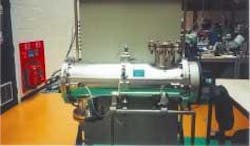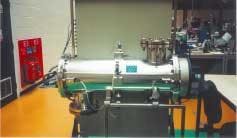UV Systems Gain Favor for Water Disinfection
U.S. Environmental Protection Agency (EPA) approval for ultraviolet (UV) light for the disinfection of potable water is only now emerging. UV is an attractive alternative to traditional potable disinfection methods because of its simplicity, ease in installation, ability for retrofit, low operating costs and capital costs.
One pioneer in the use of UV for disinfecting potable water is Severn Trent Services, offering medium pressure UV technology through its FrontLinetrademark family of municipal UV products. The FrontLine products have a multi-spectral, high-energy output enhanced in the germicidal region. This combination causes the total and permanent deactivation of micro-organisms, avoiding photoreactivation.
UV disinfection works by exposing waterborne microorganisms to UV light at a specified intensity for a specified period of time. The germicidal UV light renders the microorganism "microbiologically dead." This process consists of the UV light penetrating the cell wall and affecting the DNA in a way that the cell cannot reproduce.
When an application requires UV disinfection for high flow rates, a medium-pressure lamp (MP) is used for various reasons. The MP lamp produces a polychromatic light with a broad spectral band output ranging from 200 nm to long wavelength of visible light. The polychromatic light produced by MP lamps is enhanced in the germicidal region.
A higher amount of energy is required to operate a MP lamp, compared to low pressure lamps, because of the deeper internal vacuum pressure applied to the MP lamps during the manufacturing process. Photo-reactivation, the ability for bacterium to repair themselves after exposure to UV light, is reduced by the use of polychromatic light. Interestingly enough, while low pressure lamps tend to reduce their output based on water temperature, MP lamps are not sensitive to temperature fluctuations and are found to be effective from zero to 80
The use of UV disinfection offers advantages in municipal water treatment plants and has been proven to inactivate giardia lambia cysts and cryptosporidium parvum oocysts at specified wavelengths. Other disinfectants, including chlorine, have had difficulty in rendering these parasites harmless. Due to these recent findings, the EPA has proposed the use of UV as a best available technology (BAT) for treating drinking water, removing it from the current category of an emerging technology.
Since UV leaves no residual, another disinfectant must be added to achieve a residual. However, safety concerns surrounding the management and handling of traditional disinfectants such as chlorine are not relevant to the ultraviolet method of disinfection. In addition, there is a low potential for UV disinfection to produce organic disinfection by-products (DBPs). Since no halogens are used in the physical process, there is no need to worry about direct by-products such as THMs (trihaloamines) or HAAs (haloacetic acid).
Designed to meet the demands of the potable water industry, Severn Trent's FrontLine UV systems are constructed with chambers designed to provide highly turbulent water flow, enabling an efficient UV dose. A single unit can handle flow rates ranging from 86,000 gpd to 50 mgd.
FrontLine products are available with options such as UV monitors, transmittance monitors, temperature sensors, wiper systems, and PLC inter-link capabilities. The series is UL certified and built in compliance with ISO 9001 quality standards.

